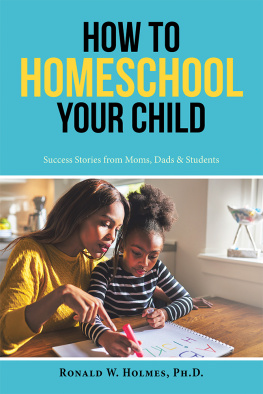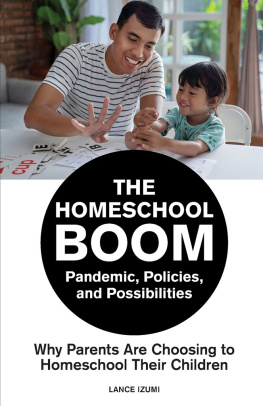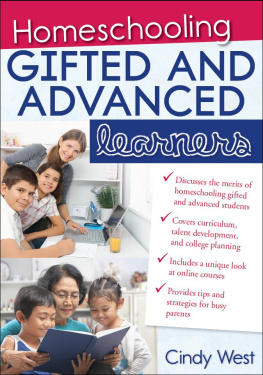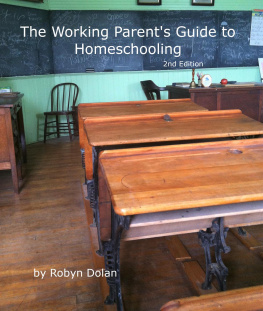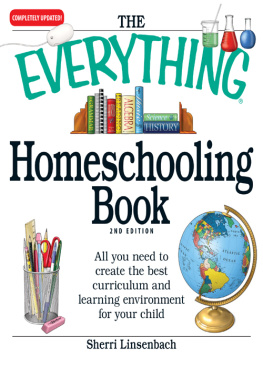HOW TO
HOMESCHOOL
YOUR CHILD
Success Stories from Moms, Dads & Students
Ronald W. Holmes, Ph.D.

AuthorHouse
1663 Liberty Drive
Bloomington, IN 47403
www.authorhouse.com
Phone: 1 (800) 839-8640
Copyright 2019 Ronald W. Holmes, Ph.D. All rights reserved.
No part of this book may be reproduced, stored in a retrieval system, or transmitted by any means without the written permission of the author.
Published by AuthorHouse 10/15/2019
ISBN: 978-1-7283-3081-5 (sc)
ISBN: 978-1-7283-3079-2 (hc)
ISBN: 978-1-7283-3080-8 (e)
Library of Congress Control Number: 2019916192
Any people depicted in stock imagery provided by Getty Images are models,
and such images are being used for illustrative purposes only.
Certain stock imagery Getty Images.
Because of the dynamic nature of the Internet, any web addresses or links contained in this book may have changed since publication and may no longer be valid. The views expressed in this work are solely those of the author and do not necessarily reflect the views of the publisher, and the publisher hereby disclaims any responsibility for them.
CONTENTS
Parental involvement is essential to the success of students in the educational setting. I am elated and amazed by the number of parents who have successfully homeschooled their children as a viable school choice option.
In writing this book, I applaud the dedicated, passionate, competent, and hard working parents who are an integral part of the educational process to educate their children especially those who have or are currently homeschooling them. Through a public, private, or homeschooling setting, parental involvement brings out the best in students academically, socially, and athletically. It affords students the best opportunity to contribute and succeed in a global and competitive world.
My interest in this topic was piqued from a communication with my dentist Dr. Delores Hubbard-Brooks who saw the value of homeschooling through one of her patients nine children. Hubbard was amazed at how well these children behaved and intellectually communicated with adults. She recommended that I consider investigating the research on homeschooling and writing a book on the topic.
As I began to investigate the topic, I noticed a gap in the literature on whether or not homeschooled students receive a quality education and socialize or interact with other students and adults outside of their home. Also, I noticed a gap in the literature on whether or not homeschooled students participate in extra-curricular activities similar to the experience of students in a traditional school setting. This guided my focus for developing and answering questions of the participants (parents and students) in the book . It also guided my focus for identifying research that explains how children develop through social relationships, interactions, and experiences with people in their surrounding environment.
Considering the time it takes to gather information and write a book, I would like to thank all the participants who shared their stories about homeschooling. I also would like to thank my wife, Constance C. Holmes, for being the editor for the book. Her continued unwavering support to my publications and service to public education is greatly appreciated.
This book is dedicated to all of the parents who have used or currently using homeschooling as a school choice.
It is my hope that this book will show the importance of parental involvement in schools, and how it is maximized through homeschooling.
Many reports such as A Nation at Risk have criticized the state of the public school system in the United States. This publication of the National Commission on Excellence in Education in 1983 contributed to the ever-growing assertion that Americas public school system was failing academically on both a national and international scale.
During the period 1963 1980, for example, the average SAT scores dropped over 50 points in the verbal section and nearly 40 points in the mathematics section. In drawing inferences from written material, nearly forty percent of 17-year olds tested could not successfully draw inferences, only one-third could solve a mathematics problem requiring several steps, and only one fifth could write a persuasive essay. In comparison to students outside of the U.S. on referencing tests conducted in the 1970s, American students were never first or second and, in comparison with other industrialized nations, were last seven times (Wikipedia).
In addition to poor academic performance, Americas public school system has been plagued by other concerns such as bullying, peer pressure, drugs, and violence. These concerns have contributed to the evolution of parents seeking other school choices to educate their children. Some choices are found in homeschooling and Americas best schools such as Thomas Jefferson High School of Science and Technology (TJHSST) in Virginia, Maine School of Science and Technology, and Stanton College Preparatory College in Florida.
The U.S. World and News Report magazine annually recognizes Americas best schools covering U.S. states and the District of Columbia based on students performance on the state reading and mathematics exams, college readiness index based participation rates in Advanced Placement and International Baccalaureate courses and the performance of students on the national exams.
Americas Best Sch ools
In 2012, I wrote in the book Current Issues and Answers in Education about the remarkable success accomplished at TJHSST as a model for other schools to benchmark and emulate. TJHSST, for example, is a high performing school that became Americas best in the country for four consecutive years, 2007 2010. TJHSST was selected from 21,786 public schools covering 48 states including the District of Columbia. TJHSST is a public magnet high school in Alexandria, Virginia operated by Fairfax County Public Schools.
When I interviewed Principal Dr. Evan Glazer about how he accomplished such success, he quickly stated that the schools success is a result of highly motivated students, a rigorous curriculum, a supportive parent community and high expectations for the academic environment. All stakeholders of the school (students, teachers, parents, etc.) consistently worked towards a common goal in accordance with the mission statement, noted Glazer.
In preparing students for college and careers, Glazer noted that TJHSST offered students a comprehensive college preparatory program with emphasis on mathematics, science and technology. Students are required to take a minimum of seven college level courses and maintain a B average in order to remain at the school. From the freshman to the senior level, students develop a skill set in research and communication skills. They participate in an intensive four-year program that includes the ninth grade IBET (Integrated Biology English and Technology), humanities, computer science, fine arts, foreign languages and physical education. Seniors are required to develop a technology laboratory project through the schools mentoring program or a specialized technical research laboratory. They are to present their projects along with the freshman class at a research symposium.
As students need additional academic assistance, the school provides an intervention team comprised of a teacher, counselor and parent. The team assesses the academic concerns of students and recommends appropriate support in the eighth period day program. The eighth period day results from increasing the school day by one hour and a half longer than other high schools in Fairfax County. During the eighth period, students gain academic assistance from their teachers and participate in extracurricular activities. At TJHSST, students also develop their own software, learning tools and schedules as network engineers. With a low turnover rate of eight percent annually, teachers use integrated technology such as web broadcast and smart boards to improve learning outcomes according to Glazer.
Next page
